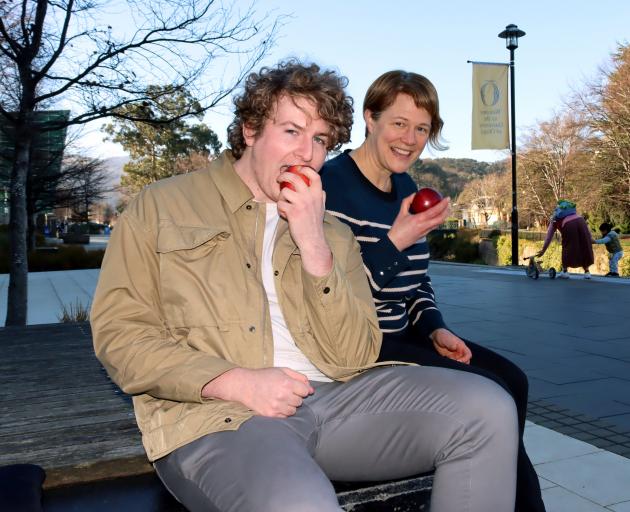Science
Master’s Student Analyzes 300 Apple Varieties for Heritage Preservation

Aaron Hewson, a master’s student specializing in plant biotechnology, is conducting significant research on over 300 apple varieties from the Jim Dunckley Heritage Orchard in New Zealand. This orchard, established 25 years ago by the Coastal Otago Branch of the New Zealand Tree Crops Association, is recognized as one of the most diverse collections of apple cultivars in the country. The orchard features uniquely named varieties, including Peasgood Nonsuch, Nonnetit Bastard, Warner’s King, and Albany Beauty.
Mr. Hewson’s research aims to support the preservation and propagation of these heritage cultivars through genetic identification. “I am doing this research for them so they can continue to preserve and propagate the heritage cultivars, with confident identification by genetic means,” he stated. The apple varieties were originally collected in the 1990s by Jim Dunckley, who sourced them from various locations across Otago and Southland, with a majority coming from an old Plant & Food Research orchard in Clyde.
The orchard’s collection is a diverse mix, with some trees named by local farmers after nearby landmarks, which can lead to discrepancies in genetic identification. For example, Mr. Hewson noted a case involving a Granny Smith apple, commonly found in supermarkets, and another named Lord Lambourne. “These two cultivars should be really different, but the samples were saying they were genetically the same. So one of those names has to be wrong,” he explained.
To determine the true genetic makeup of these apples, samples were collected by university students and staff from the Plant Biochemistry Lab. These samples were labelled, freeze-dried, and sent to a laboratory in France for analysis, with the assistance of Plant & Food Research, now part of the Bioeconomy Science Institute. Mr. Hewson credited his co-supervisor, Dr. Elena Lopez-Girona, for her invaluable expertise throughout this process. “It has been very beneficial to have her expertise,” he remarked.
The samples were analyzed using a technology known as a SNP chip, which examines approximately 50,000 known DNA hotspots in an apple leaf. This method generates a genetic fingerprint that can confirm whether two trees belong to the same variety or differ significantly. Given stringent biosecurity regulations that complicate the importation of new apple genetics, the local collection may be crucial for developing disease resistance and other beneficial traits.
Mr. Hewson emphasized the importance of genetic diversity in apple cultivation. “If we talk about the entire amount of apples across the world, there is something on the order of 10,000 different varieties. But all of our commercial varieties, no matter how many there are, they all come from six apples, so it is really, really narrow,” he said.
Associate Professor Lynnette Brownfield from the University of Otago, who also supervises Mr. Hewson, pointed out that the limited genetic base of commercial apples in New Zealand makes the identification of heritage varieties even more critical. “Identifying what is in the orchard could help breeders find fresh genes, including disease resistance, to widen future breeding options,” she noted.
The Coastal Otago Branch of the New Zealand Tree Crops Association owns the orchard and will determine how to utilize the research findings. The objective is to assign unique IDs to all trees within the collection, enabling better communication with apple breeders ranging from backyard growers to organizations like Plant & Food Research. This will facilitate the provision of germplasm as needed, thereby supporting the future of apple cultivation in New Zealand and beyond.
-

 World4 months ago
World4 months agoTest Your Knowledge: Take the Herald’s Afternoon Quiz Today
-

 Sports4 months ago
Sports4 months agoPM Faces Backlash from Fans During Netball Trophy Ceremony
-

 Lifestyle4 months ago
Lifestyle4 months agoDunedin Designers Win Top Award at Hokonui Fashion Event
-

 Entertainment4 months ago
Entertainment4 months agoExperience the Excitement of ‘Chief of War’ in Oʻahu
-

 Sports4 months ago
Sports4 months agoLiam Lawson Launches New Era for Racing Bulls with Strong Start
-

 World5 months ago
World5 months agoCoalition Forms to Preserve Māori Wards in Hawke’s Bay
-

 Health4 months ago
Health4 months agoWalking Faster Offers Major Health Benefits for Older Adults
-

 Lifestyle4 months ago
Lifestyle4 months agoDisney Fan Reveals Dress Code Tips for Park Visitors
-

 Politics4 months ago
Politics4 months agoScots Rally with Humor and Music to Protest Trump’s Visit
-

 Top Stories5 months ago
Top Stories5 months agoUK and India Finalize Trade Deal to Boost Economic Ties
-

 Health2 months ago
Health2 months agoRadio Host Jay-Jay Feeney’s Partner Secures Visa to Stay in NZ
-

 World5 months ago
World5 months agoHuntly Begins Water Pipe Flushing to Resolve Brown Water Issue









